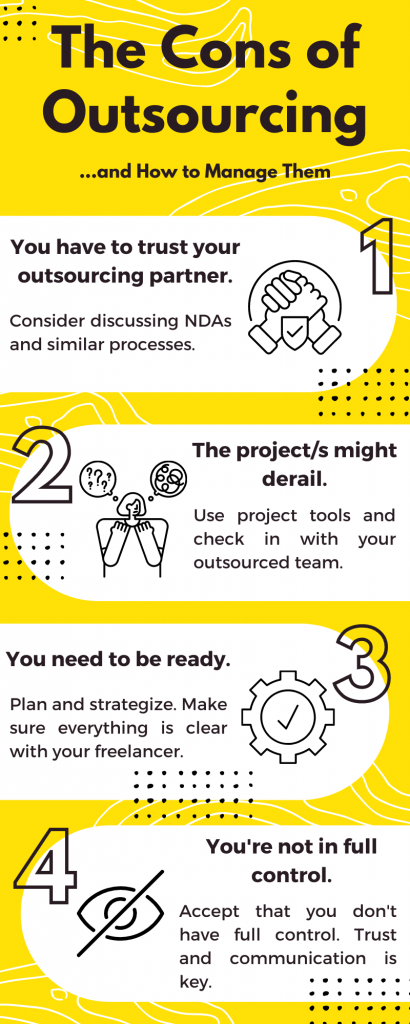
The Cons of Outsourcing (and How to Manage Them)
CATEGORIES
Tags
24/7 analytics australia automation Business Process Outsourcing company Copywriting CRM customer support data data and analytics Delegate digital digital advertising digital marketing Digital Support Staff ecommerce Email Management Email Marketing Entrepreneur Freelance Writers google ads graphic design Hiring Freelancers Marketing offshore offshoring ominchannel support organizer outsource Outsourcing Philippines Project management reporting seo seo audit Shopify Small Business social media Social media experts social media management United States video Virtual Assistant Virtual Team
Like many good things, outsourcing also has cons. Not many and not much to discourage you from hiring freelancers, but enough for you to need inner and outer zen to make you battle-ready while still in the planning stages.
Like all projects, outsourcing also needs outlines and layouts. Imagine your blank doc or spreadsheet. Add a sub-heading or column for outsourcing, and below that header, add the pros we’ve already outlined in previous posts. In another column, add the following conditions and your strategy on how to manage them.
1. You have to trust your outsourcing partner.
Outsourcing tasks and projects come with a risk to your security and privacy. A very low risk–and nothing untoward happens 99% of the time–but it’s there. Aside from confidentiality, 8% of small businesses think there’s a threat to data security.
Outsourcing agencies and most freelancers understand your proprietary rights. Insider secrets and information are kept. It’s part and parcel of professionalism. All the same, consider:
-
- Would you require an NDA (non-disclosure agreement)?
- What parts of the projects/processes would you need to keep to yourself/your core team?
- Are you willing to mentor someone with your methods even if the freelancer won’t be with you long-term?
2. The project/s might run away from you or veer off somewhere you didn’t plan.
Because they are remote minions and not under your nose, there are cases where your freelancer/s do tasks vastly differently, or complete an altogether different task–not how and what you wanted.
The worst-case scenarios: 14% of small businesses experienced working with freelancers who failed to meet their deadlines, 12% hired providers who didn’t follow instructions and 9% received low-quality service.
But that’s less likely. The best freelancers need very little supervision and do have great pride in their work. To avoid lapses in the direction of the work itself, keep communication open. Both parties should be responsive.
Regularly check in so that your freelancer/s continue to produce desired results. Make the best out of communication and project management tools. Mandate a daily or weekly progress update as you see fit. Either you or someone in your core team does this: keep things on point and in the right direction.
3. You need to make sure you’re ready before you outsource.
You need to plan and strategize. When you hire freelancers in a misguided urgency, instead of making a sound investment as outsourcing usually is, you might only lose money and time.
You don’t get results and real returns because you haven’t mapped out what results you wanted.
You need to prepare things before outsourcing.
Start by defining your brand and your buyer persona. Who do you want to reach and what do you want to say to them?
Familiarize yourself with the task you want to outsource – this is so you can create the ideal candidate.
Your tasks can vary from SEO, reporting and analytics, customer support, virtual assistant, and digital advertising, to web development tasks.
Prepare a detailed list of your goals set on a reasonable timeline. Specify if you want to target or retarget a market, improve clickthrough rates, or increase conversion traffic before you hire an SEO. Know that their process changes based on what you want them to achieve.
Before hiring customer support or virtual assistant, identify their tasks. Your hiring and training requirements and be specific in your SOP. If it’s a digital advertiser, finalize your target audience and your advertising goals.
Graphic designers and web developers have their styles. Check their portfolio, and consider whether your brand personality fits perfectly with the style of your freelancer.
If you have a vision and an outline to achieve that vision, hiring out and working for you is a two-way smooth street. You’re good, and your freelancers also feel and do good.
4. You are not in full control.
Freelancers are freelancers for the very reason that they’re good at what they do with minimal interference–and they prefer it that way. When you outsource, you have to give up a level of control. This is positive: you’re no longer stuck in the middle of the work. You have freedom.
When you outsource, there’s an initial and ongoing consultation, and then your freelancer proceeds. That’s just good work well done.
If you or your superiors/under managers are inclined toward micromanaging, outsourcing is NOT for you.
How to keep a close eye? Milestone progresses as needed for the tasks. Use collaboration and communication management tools like ClickUp, Trello, Asana, Slack, and Google Hangouts.
If it’s not important to the outcome, care for the WHAT and WHEN, the results and the deadlines, not the minutiae of the HOW.
You can and should still have SOPs that your freelancers can follow. Being clear about your preferences and processes removes a lot of friction from freelancers doing things their way.
Outsourcing has a ton of benefits. As for the challenges, you can resolve all of them with open communication. It all boils down to responsiveness on both sides.


